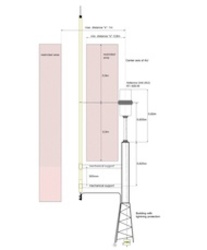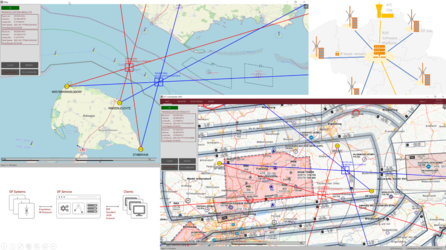Lightning protection rod

The Lightning Protection Rod for precision direction finders is designed to protect direction finders from RHOTHETA against the effects of direct lightning strokes into a direction finder system.

The RT-800 is a radio direction finder for stationary coast surveillance and identification of ships that are transmitting on the VHF radio band. The bearing information from transmitters can be correlated with the corresponding radar target and AIS-position information at a VTS centre. Two or more RT-800 Systems on different locations can be used to locate a ship’s exact position by triangulation. The RT-800 can easily be integrated in a VTS environment.
• A-Class System according to IALA recommendations (IALA Guideline No. 1111)
• Best relation of performance and price
• Decoding of transmissions on all 19 Cospas-Sarsat channels
• Bearing (finding the direction) of the Cospas-Sarsat
• Full manual operational functionality at installation site for calibration and service
• Fast frequency monitoring by scanning of up to 8 frequencies
• Low costs due to no moving parts
• Easy and reasonable priced installation as no patched HF antenna cable has to be used
• Effective remote operation via RS-232, Ethernet and LAN
• Extreme compact, rugged and light-weight DF antenna for easy installation and use in maritime weather conditions
• Maintenance-free due to no moving parts
• External lightning protection available
|
Method of bearing |
Doppler-principle (3kHz rotational frequency) |
|
Bearing accuracy |
≤ 2° (RMS) |
|
Internal resolution |
1° |
|
Stability of frequency |
±2.0 ppm |
|
Frequency range |
VHF air band: 118.000 to 124.000 MHz
Frequency extensions possible see below in Accessories |
|
Channel pattern |
VHF Air Band: 8.33 kHz
|
|
Monitoring/Scanning modes: |
Monitoring:
|
|
Signal filtering |
Optional: all emergency frequencies can be filtered for Distresssignal-modulation (false alarms disabled). |
|
Cospas-Sarsat analysis |
Reception and analysis of Cospas-Sarsat data signal (112 or 144bit, 400baud, biphase L-phase modulated, with Bose-Chaudhuri-Hocquenghem error test, specified according Cospas-Sarsat C/S T.001 October 1999)
|
|
Bearable modulation types |
A3E, F3E, A2X (PLB-modulation); bearing largely independent of modulation. |
|
Polarisation |
vertical |
|
Polarisation error |
≤ 5° at 60° field vector rotation |
|
Garbling cone |
approx. 30° to vertical |
|
Response time |
≤ 50 ms typ. (with sufficient reception field strength) |
|
Keyboard |
Foil on the front with integrated keyboard matrix and EL background illumination |
|
TFT Graphic Display |
320 x 240 pixel with max. brightness of approx. 450cd/m2, continuously adjustable or automatic control. |
|
Power supply |
115 V to 230 V ± 10 % AC,
|
|
Rated Current |
0,5 to 1 A |
|
Audio out |
Internal speaker 4W Line out (adjustable from 100mV pp to 2000mV pp) |
|
Data Interfaces |
Remote Control Channel 1 Audio: Ethernet LAN (RJ45)
|
|
Weight |
AU: approx. 5200 g
|
|
Operating temperature |
DCU: -20 °C to +60 °C
|
|
Bearing senitivity VHF Air Band |
≤ 4 µV/m / 2,5 µV/m typical at ±5° bearing fluctuation |
|
Bearing sensitivity VHF Marine Band, |
≤ 3 µV/m / 2 µV/m typical at ±5° bearing fluctuation |
|
Bearing sensitivity UHF Air Band |
≤ 6 µV/m / 4 µV/m typical at ±5° bearing fluctuation |
|
Bearing sensitivity COSPAS-SARSAT |
≤ 6 µV/m / 4 µV/m typical at ±5° bearing fluctuation |
|
Bearing sensitivity UHF FM-Band |
≤ 6 µV/m / 4 µV/m typical |
|
Power Consumption |
30 W at 230 V |
Lightning protection rod

The Lightning Protection Rod for precision direction finders is designed to protect direction finders from RHOTHETA against the effects of direct lightning strokes into a direction finder system.
Optional Frequency extensions

F1 VHF-Airband: 118,000 – 136,992 MHz
F2 VHF-Marineband: 137,000 – 224,995 MHz
F3 UHF-Airband: 225,000 – 399,975 MHz
F4 UHF-FM Band: 406,100 – 470,000 MHz
The Optional Frequency extensions can be ordered seperatly to extend the frequency range of each system individually.
DF Commander Software

The main purpose of the “DF Commander" Software is to provide the remote control and monitoring of multiple DF-Channels and DF-Systems from a standard PC. This software allows the visualizing of the bearing data, such as bearing angle, signal level and frequency of an appropriate channel. The simple and convenient design of the “Bearing Page” and the possibility to adjust the orientation of the compass rose towards the tower window view makes the controller’s work very comfortable.
Furthermore the software provides the possibility to simultaneously monitor the status of all channels connected, which is also a helpful feature for the technical monitoring and maintaining of the DF-System.
DF Commander MK2 Software

The DF Commander MK2 software enables remote control and monitoring of radio direction finding systems. Besides displaying the direction finding results on different electronic charts, the software is able to calculate cross bearings on different frequencies. Soundings, cross bearing results and status information of radio direction finding systems are made available via an integrated server. Radio direction finding systems can also be set and controlled via the same server. Thus the software is to be understood as a DF service.
DF-Emmulator Software

The "DF Emulator" is a software that emulates a bearing system on a Windows PC by playing a pre-recorded log file. In the simplest case, the DF emulator uses the serial COM port of the PC to transfer the data via RS232 to another PC or system that displays the bearing data.
This software is designed for projects like bearing data integration in radar displays or other map- and control displays and is intended to facilitate the work of integrators.
GPS UTC Timebase

By connecting the RT-800 with a GPS-mouse, it is possible to provide a peak data packet transmitted via LAN with a UTC time stamp. This ensures that it is possible to display the pitch data of different direction finding systems in a synchronized manner and triangulation for position determination on a map software becomes possible.